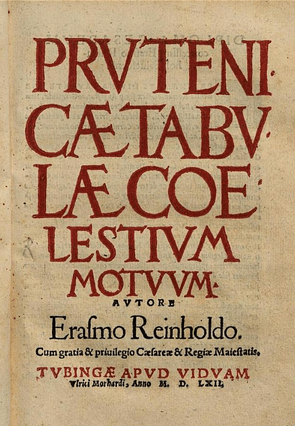Erasmus Reinhold facts for kids
Quick facts for kids
Erasmus Reinhold
|
|
|---|---|
| Born | 22 October 1511 Saalfeld, Electorate of Saxony
|
| Died | 19 February 1553 (aged 41) Saalfeld, Electorate of Saxony
|
| Nationality | German |
| Alma mater | University of Wittenberg |
| Scientific career | |
| Fields | Astronomer and mathematician |
| Institutions | University of Wittenberg |
| Academic advisors | Jacob Milich |
| Notable students | Johannes Hommel Valentine Naibod Caspar Peucer |
Erasmus Reinhold (born October 22, 1511 – died February 19, 1553) was a German astronomer and mathematician. He was known as one of the most important astronomy teachers of his time. Reinhold was born and passed away in Saalfeld, a town in Saxony, Germany.
Contents
Early Life and Education
Erasmus Reinhold studied at the University of Wittenberg. His teacher there was Jacob Milich. After finishing his studies, Reinhold became a dean at the university. Later, he even became the rector, which is like the head of the university.
In 1536, he was made a professor of higher mathematics. At that time, "mathematics" included many subjects. It wasn't just about numbers. It also covered applied mathematics, especially astronomy. So, Reinhold taught about the stars and planets.
His Work in Astronomy
Reinhold spent a lot of time mapping the positions of many stars. He also wrote books about astronomy. One important book was a commentary on Theoricae novae planetarum by Georg Purbach. This book explained how planets moved.
Reinhold knew about Copernicus and his idea that the Earth goes around the Sun. This was before Copernicus's famous book, De revolutionibus, was even published! Reinhold even mentioned Copernicus positively in his commentary.
However, Reinhold did not fully agree with Copernicus's idea that the Earth moves. Like many astronomers back then, he used Copernicus's math but kept the Earth at the center of the universe. This was because of common beliefs about physics and religion at the time.
The Prussian Tables
Duke Albert of Brandenburg Prussia helped Reinhold a lot. He paid for the printing of Reinhold's most famous work, the Prutenicae Tabulae (which means Prussian Tables). These tables were published in 1551 and reprinted several times.
The Prussian Tables were very important. They helped spread Copernicus's calculation methods all over Europe. Even though Reinhold didn't fully support the idea of the Earth moving, his tables used Copernicus's math. This made Copernicus's ideas more widely known.
These tables, along with Copernicus's studies, were used later to help reform the calendar. This led to the Gregorian Calendar that we use today, which was created in 1582.
Reinhold's Notes on Copernicus
Reinhold had his own copy of Copernicus's book, De revolutionibus. This copy had many notes written by Reinhold himself. This special book is now kept at the Royal Observatory, Edinburgh.
A historian named Owen Gingerich found Reinhold's copy. It inspired him to search for other copies of Copernicus's book. Gingerich wrote a book about his search called The Book Nobody Read.
In his own notes, Reinhold tried to calculate the distance from the Earth to the Sun. He adjusted his calculations to get an answer that was similar to what the ancient astronomer Ptolemy had found.
Legacy
Today, there is a crater on the Moon named after Erasmus Reinhold. It is a prominent impact crater located near the famous Copernicus crater.


